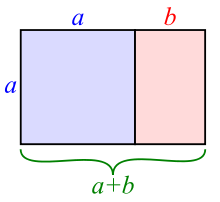黄金比例
| 黄金比 | ||
|---|---|---|
| ||
 黄金比例的线段 | ||
| 命名 | ||
| 名称 | 黄金比例 黄金分割比 黄金分割率 | |
| 识别 | ||
| 种类 | 无理数 | |
| 符号 | ||
| 位数数列编号 | ||
| 性质 | ||
| 连分数 | ||
| 以此为根的多项式或函数 | ||
| 表示方式 | ||
| 值 | 1.61803... | |
| 代数形式 | ||
| 二进制 | 1.100111100011011101111001… | |
| 十进制 | 1.618033988749894848204586… | |
| 十六进制 | 1.9E3779B97F4A7C15F39CC060… | |
黄金比例(英语:golden ratio),又称黄金比、黄金分割比[1]、黄金分割率,是数学常数,一般以希腊字母表示[2][3][4]。可以以下代数式定义:
这也是黄金比一名的由来。
黄金比是无理数,准确值为,约值(小数点后20位,![]() A001622):
A001622):
- =1.61803398874989484820…
应用时一般取1.618,就像圆周率在应用时取3.14159一样。
黄金比有严格的艺术感、和谐感,蕴藏丰富的美学价值,而且呈现于不少动物和植物的外观。现今普遍很多工业产品、电子产品、建筑物或艺术品均应用了黄金比,使其更美观。
历史
[编辑]黄金比例是属于数学领域的专有名词,但最后涵盖的内容不只是有关数学领域的研究,根据目前的文献探讨,我们可以说,黄金比的发现和如何演进至今仍是个谜。但有研究指出公元前六世纪古希腊的毕达哥拉斯学派研究过正五边形和正十边形的作图,因此现代数学家推断当时毕达哥拉斯学派已经触及甚至掌握了黄金比的一些规则,也发现无理数,但由于其数字崇拜的宗教信仰拒绝承认其存在。它侧重于从数学关系去探讨美的规律,并认为美就是和谐与比例,按照这种比例关系就可以组成美的图案,这其实是一个数字的比例关系,即将一条线分成两部份,长段与短段之比等于全长与长段之比,它们的比例大约是1.618比1,知名的费氏数列也体现了这数学原则,按此种比例关系组成的任何事物都表现出其内部关系的和谐与均衡。
公元前四世纪,古希腊数学家欧多克索斯第一个系统研究了这一问题,并建立起比例理论。公元前300年前后欧几里得撰写《几何原本》时吸收了欧多克索斯的研究成果,进一步系统论述了黄金比,成为最早的有关黄金比的论著(即中末比)[5]。
中世纪后,黄金比被披上神秘的外衣,义大利数学家卢卡·帕乔利称中末比为神圣比例,并专门为此著书立说。德国天文学家约翰内斯·开普勒称神圣比例为黄金比。到19世纪黄金比一名才逐渐通行,而证据在于德国数学家马丁·欧姆所写的《基本纯数学》第2版注释中有关黄金比的解释:“人们习惯把按此方式将任一直线分割成两部份的方法,称为黄金比”。而在1875年出版的《大英百科全书》第9版中,苏利有提到:“由费区那……提出的有趣、实验性浓厚的想法宣称,‘黄金比’在视觉比例上有所谓的优越性。”可见黄金比在当时已甚为流行。20世纪时美国数学家马克·巴尔给它个名叫phi。黄金比有许多有趣的性质,人类对它的实际应用也很广泛,造就了它今天的名气。最著名的例子是优选学的黄金比法或0.618法,是由美国数学家杰克·基弗于1953年首先提出,70年代在中国推广。
基本计算
[编辑]
两个数值和构成黄金比例,如果:
一个得出数值的方法是从左边的分数式入手。经过简化和代入,
于是:
两边乘以就得到:
即是
黄金比奇妙之处在于其倒数为自身减1,即0.618…=1.618…-1,并时常称为“黄金比例共轭”[6]。
从上面的得到:
0.618…的数值常用希腊字母表示,即:
- =0.6180339887…,亦可表达为:
- =-1=1.6180339887…-1=0.6180339887…
替代或其他形式
[编辑]
而它的倒数是:
平方根表示:
即是:
与其他数学事项的关系
[编辑]黄金比数高精度计算程式码
[编辑]C++
[编辑]#includes <iostream>
#includes <stdio.h>
using namespace std;
int main() {
long b, c, d = 0, e = 0, f = 100, i = 0, j, N;
cout << "請輸入黃金分割數位數\n";
cin >> N;
N = N * 3 / 2 + 6;
long* a = new long[N + 1];
while (i <= N) a[i++] = 1;
for (; --i > 0;
i == N - 6 ? printf("\r0.61") : printf("%02ld", e += (d += b / f) / f),
e = d % f, d = b % f, i -= 2)
for (j = i, b = 0; j; b = b / c * (j-- * 2 - 1))
a[j] = (b += a[j] * f) % (c = j * 10);
delete[] a;
cin.ignore();
cin.ignore();
return 0;
}
例子
[编辑]贵金属分割
[编辑]贵金属分割即,其中为正整数。时为黄金比(),时为白银比(),时为青铜比()。用连分数可表示为
参考文献
[编辑]引用
[编辑]- ^ Summerson John, Heavenly Mansions: And Other Essays on Architecture (New York: W.W. Norton, 1963) p. 37. "And the same applies in architecture, to the rectangles representing these and other ratios (e.g. the 'golden cut'). The sole value of these ratios is that they are intellectually fruitful and suggest the rhythms of modular design."
- ^ Livio, Mario. The Golden Ratio: The Story of Phi, The World's Most Astonishing Number. New York: Broadway Books. 2002 [2016-07-12]. ISBN 0-7679-0815-5. (原始内容存档于2016-07-07).
- ^ Piotr Sadowski. The knight on his quest: symbolic patterns of transition in Sir Gawain and the Green Knight. University of Delaware Press. 1996: 124 [2016-07-12]. ISBN 978-0-87413-580-0. (原始内容存档于2016-07-07).
- ^ Richard A Dunlap, The Golden Ratio and Fibonacci Numbers, World Scientific Publishing, 1997
- ^ Strogatz, Steven. Me, Myself, and Math: Proportion Control. New York Times. 2012-09-24 [2016-07-12]. (原始内容存档于2016-02-12).
- ^ Weisstein, Eric W. (编). Golden Ratio Conjugate. at MathWorld--A Wolfram Web Resource. Wolfram Research, Inc. (英语).
- ^ Max. Hailperin; Barbara K. Kaiser; Karl W. Knight. Concrete Abstractions: An Introduction to Computer Science Using Scheme. Brooks/Cole Pub. Co. 1998. ISBN 0-534-95211-9.
- ^ Brian Roselle, "Golden Mean Series" (页面存档备份,存于互联网档案馆)
- ^ "黄金分割数高精度计算.pdf"[永久失效链接]
来源
[编辑]- 《黄金比例》;远流出版公司;2004年;ISBN 957-32-5270-8.
注释
[编辑]延伸读物
[编辑]- Doczi, György. The Power of Limits: Proportional Harmonies in Nature, Art, and Architecture. Boston: Shambhala Publications. 2005 [1981]. ISBN 1-59030-259-1.
- Huntley, H. E. The Divine Proportion: A Study in Mathematical Beauty. New York: Dover Publications. 1970. ISBN 0-486-22254-3.
- Joseph, George G. The Crest of the Peacock: The Non-European Roots of Mathematics New. Princeton, NJ: Princeton University Press. 2000 [1991]. ISBN 0-691-00659-8.
- Livio, Mario. The Golden Ratio: The Story of PHI, the World's Most Astonishing Number Hardback. NYC: Broadway (Random House). 2002 [2002]. ISBN 0-7679-0815-5.
- Sahlqvist, Leif. Cardinal Alignments and the Golden Section: Principles of Ancient Cosmography and Design 3rd Rev. Charleston, SC: BookSurge. 2008. ISBN 1-4196-2157-2.
- Schneider, Michael S. A Beginner's Guide to Constructing the Universe: The Mathematical Archetypes of Nature, Art, and Science. New York: HarperCollins. 1994. ISBN 0-06-016939-7.
- Scimone, Aldo. La Sezione Aurea. Storia culturale di un leitmotiv della Matematica. Palermo: Sigma Edizioni. 1997. ISBN 978-88-7231-025-0.
- Stakhov, A. P. The Mathematics of Harmony: From Euclid to Contemporary Mathematics and Computer Science. Singapore: World Scientific Publishing. 2009. ISBN 978-981-277-582-5.
- Walser, Hans. The Golden Section. Peter Hilton trans. Washington, DC: The Mathematical Association of America. 2001 [Der Goldene Schnitt 1993]. ISBN 0-88385-534-8.


























![{\displaystyle \varphi =[1;1,1,1,\dots ]=1+{\cfrac {1}{1+{\cfrac {1}{1+{\cfrac {1}{1+\ddots }}}}}}}](https://wikimedia.org/api/rest_v1/media/math/render/svg/95682588ffee3530627c3a7b00ff08bbba6e97d4)
![{\displaystyle \varphi ^{-1}=[0;1,1,1,\dots ]=0+{\cfrac {1}{1+{\cfrac {1}{1+{\cfrac {1}{1+\ddots }}}}}}}](https://wikimedia.org/api/rest_v1/media/math/render/svg/165d255e32f4b9af1f9144f15302b147fc3fead2)


























![{\displaystyle n+{\cfrac {1}{n+{\cfrac {1}{n+{\cfrac {1}{n+{\cfrac {1}{\ddots }}}}}}}}=[n;n,n,n,n,\dots ]}](https://wikimedia.org/api/rest_v1/media/math/render/svg/e95c55de273af96c5fcd4a6cc7fc45fc1022d0f1)





